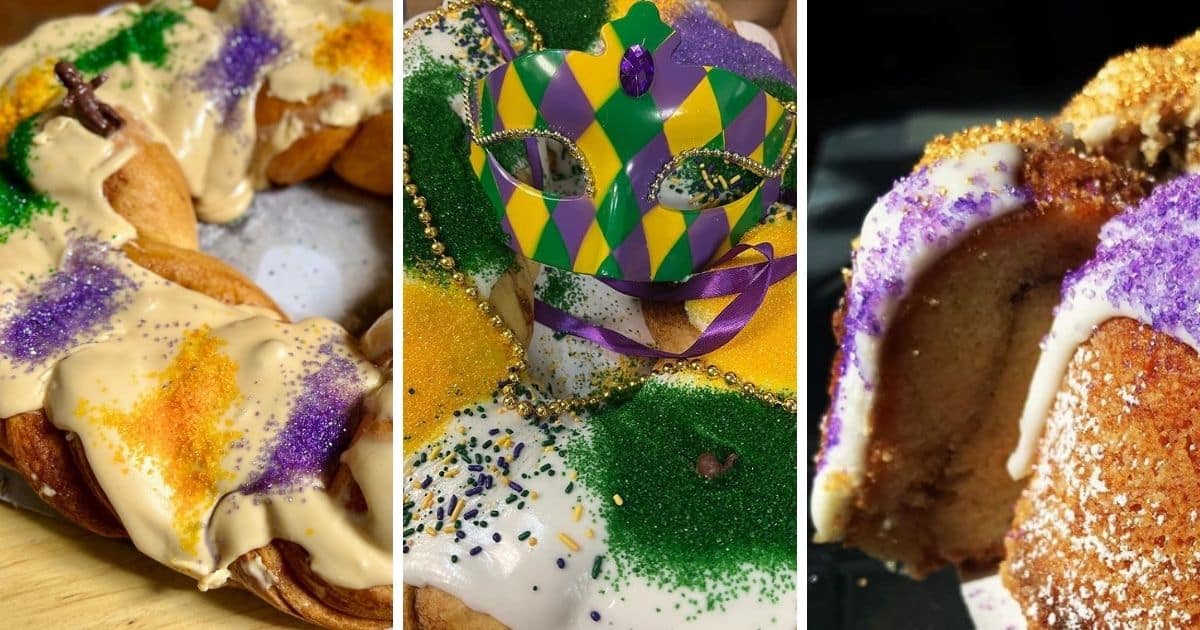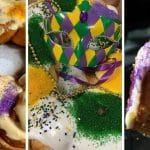
16 Feb Everyone Loves King Cake
There are so many traditions associated with the New Orleans celebration of Mardi Gras or Carnivale; one could be forgiven for not knowing them all. There are the parades, the costumes, the music, the beads—and then there is King Cake! If you haven’t heard of it, King Cake is an amazing pastry bursting with buttery flavor. Typically, it’s an oval-shaped ring decorated with bright red and green sections. Ranging from flakier to denser crusts, the treat marks the beginning of the Mardi Gras season for many. For others, it sticks around for all the weeks leading up to the final Fat Tuesday!
So why is it called King Cake anyway? As you may already know, the Mardi Gras season begins with the end of the “Twelve Days of Christmas” and concludes with the advent of Lent. In this way, the weeks in between are a sort of bridge observing the birth of Jesus and the events leading up to the miracle of Easter. In the Christian tradition, as observed in New Orleans and many other places, this is cause for great revelry and joy. Since it all starts on the “Three Kings Day”—aka, the 12th Day of Christmas—that’s where the cake gets its name.
You might recall that the three kings from the east traveled to visit Jesus shortly after his birth. Guided by a star that was hovering over the child’s birthplace, this event is also known as The Epiphany, since it was divine inspiration that drove these three wise kings to travel and meet the newly come savior. In places like France and Spain, both of which contribute heavily to the culture of New Orleans, The Epiphany is observed as a day almost as important as Christmas itself. The King Cake was created in honor of those wandering royal figures who are central to the story.
But that’s not all! There’s so much more to know about King Cake! Where and when did this tradition start? What makes it taste so darn good? Where and when do you get it? And, oh yes—why the heck is there a plastic baby hidden inside? Read on for some delicious answers!
A Deep Dive Into the World of King Cake
Let’s start by going all the way back to King Cake’s origins. We’re talking way back to the Middle Ages! In those times, the regions we now know as Spain and France began the tradition of making a version of King Cake to be served on the day of The Epiphany to honor the Three Kings. In turn, their own tradition likely reflected one from even earlier in the Roman Empire and its Saturnalia celebrations, where a meal was shared between slaves and nobles. It makes sense that the practice was adopted by Christians since Jesus preached about loving one another and helping the poor. A dry bean was traditionally placed in the cake, and the lucky person served that piece was declared king for the day—a detail to keep in mind!
Fast forward to the settling of New Orleans. Both the French and Spanish colonized the area we now know as The Big Easy for long periods of time. Several elements of both cultures infused themselves into the population over the centuries, combining with African traditions contributed by the enslaved peoples living there as well. From the garish costumes reminiscent of the Parisian aristocracy to the African American creation of jazz music, you can see it all swirling into the celebrations. As America’s most potent original melting pot, from here issues NOLA’s own traditions, including the Mardi Gras festivals. Even the King Cake, the most famous of the season’s foods, would take on its own local form.
Back in its origins in France and Spain, King Cake was a little different. The Spanish version was a sweet brioche dough flavored with orange blossoms and decorated with candied fruits, and it might be filled with almond paste or cream. In France, it was more likely to be a puff pastry loaded with frangipane, an almond custard, and they would be shaped like ovals or just round cakes. But in New Orleans, it’s most often a ring of twisted cinnamon-style dough filled with cream cheese, praline, or strawberry. Instead of a bean inside—there’s something else! Like so many other things about NOLA, that special added element sets apart not only this version of the cake but also the unique spirit of this very special and spirited place.
Why King Cake on Mardi Gras?
To fully understand the King Cake tradition in New Orleans is to understand just what a big deal Mardi Gras itself is. Unlike in most of America, New Orleans doesn’t just leave things alone between Christmas and Easter. With the long-term impact of French colonization, NOLA was having Mardi Gras as far back as 1699. In some ways, the overtaking of the area by the Spanish and, eventually, Americans may have pushed Creole folks to fight even harder to keep it going. Since The Epiphany kicks off the season and the old cake tradition was key to that event, this is the day you start eating King Cake. Eating it before that day is considered sacrilege, and you won’t find any after Fat Tuesday!
Now, the New Orleans King Cake doesn’t have a bean inside of it to make you king for a day. Instead, there is a baby inside! To be more exact, a plastic baby lurks within a random slice of the King Cake. This symbolizes Baby Jesus, the object of the Kings’ journey on that day. If you are the lucky one who gets the plastic or porcelain baby in your slice, that means you either have to bring the King Cake to the next celebration or must act as host of the next Mardi Gras party! Ready to throw a shindig in the French Quarter, y’all? It’s taken as a serious responsibility, so understand what you’re getting into when eating the cake!
While New Orleans is the king of King Cake, many Gulf Coast communities, like Mobile, Alabama, join in the fun. Even places a little further from those warm waters, such as Orlando, Florida, and St. Louis, Missouri, follow the tradition. Those in Spanish-speaking countries in South America may also find Baby Jesus figurines in their King Cakes, which they are supposed to take to the nearest church. In Portugal, they still use a dry fava bean to crown the king, and the lucky winner there has to buy next year’s cake! In France, the figurine could be a traditional religious character or even a modern-day pop culture character.
Who made the King Cake?
The King Cake of New Orleans, as we now know it, has one final bit of origin story to it. With the aforementioned traditions firmly in place, one more piece had to come—who replaced the bean with Baby Jesus? While adopting the bean in the cake started with a 19th-century Mardi Gras group called the Twelfth Night Revelers, it wasn’t until the 1950s that a baker named Donald Entringer, patriarch of beloved NOLA bakery McKenzie’s, was convinced to buy a bunch of tiny dolls by a traveling salesman. Already a King Cake-making king of his own, he started the Baby Jesus tradition with those dolls.
You could also make your own King Cake at home following any of the dozens of recipes available online. It takes a few hours, with about 45 minutes of prep time. You’ll be using milk, butter, eggs, flour, salt, and spices to make the pastry. Fillings will vary, but most will have chopped pecans or almonds, brown sugar, flour, and cinnamon. Then there is the colored glaze—and don’t forget the plastic baby! King Cakes will keep for up to three months in the freezer—just don’t eat any after Fat Tuesday! (Unless you must!)
Where to buy King Cake?
Nowadays, there are many incredible bakeries putting sugar and flour to good use in King Cakes. You can order these cakes for shipping all over the United States, expecting the very same fine quality you would find in NOLA. Some of our favorite bakeries for King Cake and King Cake alternatives include:
- The Gr8 Debake (Round Rock, TX)
- Buttery Spell (New Orleans, LA)
- Original Thought NOLA (New Orleans, LA)
- The Cupcake Collection NOLA (Nashville, TN and New Orleans, LA)
- Loretta’s Authentic Pralines – (New Orleans, LA)
- Adrian’s Bakery (New Orleans, LA)
- B Sweet Bistro (New Orleans, LA)
- Anointed Confections (Gretna, LA)
- Ina Mae Tavern – (Chicago, IL)
- La Vie En Rose Cafe Nola (New Orleans, LA)
King Cake, the Symbol
While we now can see that King Cake has a long history stretching back across the ocean to Europe, there is no denying that the beloved sugary treat is today a symbol of New Orleans. If you haven’t heard of it until now, take your chance to take part in this delicious tradition! Use the Mardi Gras season wherever you are to get your hands on some King Cake. When you sink your teeth into it, remember New Orleans and see if it’s your lucky day to become royalty yourself!
Author: Black Restaurant Week
Content Team



Karen Milligan
Posted at 02:15h, 21 FebruaryI’m a New Orleanian and cannot believe you don’t have Randazzo’s on this list!!! By far, their king cakes are the best. If you don’t know, you better ask somebody! lol